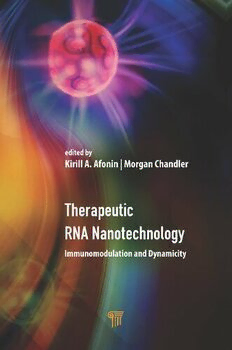
Therapeutic RNA Nanotechnology: Immunomodulation and Dynamicity PDF
Preview Therapeutic RNA Nanotechnology: Immunomodulation and Dynamicity
Therapeutic RNA Nanotechnology Therapeutic RNA Nanotechnology Immunomodulation and Dynamicity edited by Kirill A. Afonin | Morgan Chandler Published by Jenny Stanford Publishing Pte. Ltd. Level 34, Centennial Tower 3 Temasek Avenue Singapore 039190 Email: [email protected] Web: www.jennystanford.com British Library Cataloguing-in-Publication Data A catalogue record for this book is available from the British Library. Therapeutic RNA Nanotechnology: Immunomodulation and Dynamicity All rights reserved. This book, or parts thereof, may not be reproduced in any form Copyright © 2021 by Jenny Stanford Publishing Pte. Ltd. or by any means, electronic or mechanical, including photocopying, recording or any information storage and retrieval system now known or to be invented, without written permission from the publisher. For photocopying of material in this volume, please pay a copying fee through the Copyright Clearance Center, Inc., 222 Rosewood Drive, Danvers, MA 01923, USA. In this case permission to photocopy is not required from the publisher. ISBN 978-981-4877-18-3 (Hardcover) ISBN 978-1-003-12200-5 (eBook) Dedication Kirill Afonin dedicates this book to the memory of his mentor and teacher, Prof. Neocles Leontis, who left us too early. Without him, this work would have never been possible. Contents Preface Part I Nano design xlvii 1. Generating New Specific RNA Interaction Interfaces Using C-Loops 3 Kirill A. Afonin and Neocles B. Leontis 1.1 Introduction 4 1.2 Materials and Methods 5 1.2.1 Design of the C-Loop-Containing Tectonics 5 1.2.2 RNA Preparation 6 1.2.3 pCp Labeling of RNA Molecules 7 K 1.2.4 Assembly Experiments 7 1.2.5 Dissociation Constants ( d) Determination 8 2+ 1.2.6 Lead (Pb )-Induced Cleavage 8 1.3 Results 8 1.3.1 Design and Nomenclature of C-Loop- Containing Tecto-RNA Molecules 8 K 1.3.2 Assembly Experiments and Dissociation Constants ( d’s) 9 1.3.3 Competition Experiments 13 1.3.4 Monitoring C-Loop Formation by Pb(II)-Induced Cleavage 14 1.4 Discussion 16 2. 1Sp.5e cific CRoNnAc lSueslifo-Ans sembly with Minimal Paranemic 19 Motifs 21 Kirill A. Afonin, Dennis J. Cieply, and Neocles B. Leontis 2.1 Introduction 22 2.2 Materials and Methods 26 viii Contents 2.2.1 Sequence Design 26 2.2.2 RNA Preparation 27 2.2.3 Radio-Labeling of RNA Molecules 27 2.2.4 Assembly Experiments 27 K 2.2.5 Determination of Dissociation Constants ( d) 28 2+ 2.2.6 Lead (Pb )-Induced Cleavage 29 2.3 Results 29 2.3.1 Designs of RNA Molecules for Paranemic Assembly 29 2.3.2 Paranemic RNA Self-Assembly 30 2.3.3 Using Pb(II) to Probe the Formation of Paranemic Complexes 31 2.3.4 Kinetic Exchange 33 2.3.5 Sequence Specificity 35 2.3.6 Determination of Dissociation Constant for 3HT Complexes 39 2.4 Discussion 40 3. 2In.5 v itro CAossnecmlubsliyo no f Cubic RNA-Based Scaffolds 42 designed in silico 45 Kirill A. Afonin, Eckart Bindewald, Alan J. Yaghoubian, Neil Voss, Erica Jacovetty, Bruce A. Shapiro, and Luc Jaeger 3.1 Introduction 46 3.2 Rational Design of a Nanocube 47 3.3 Nanocube Self-Assembly 49 3.4 Comparison of RNA, DNA and RNA/DNA Nanocubes 51 3.5 Structural Characterization by DLS and Cryo-EM 53 3.6 RNA Nanocube Functionalization 55 3.7 Conclusion 58 3.8 Methods 58 3.8.1 RNA Preparation 58 3.8.2 pCp Labelling of RNA Molecules 59 3.8.3 ATP Labelling of DNA 59 Contents ix 3.8.4 Self-Assembly of RNA and DNA Cubes 59 K 3.8.5 Non-denaturing PAGE, TGGE Experiments and d Measurements 59 3.8.6 Assembly of RNA Cubes during Transcription 60 3.8.7 Dynamic Light Scattering 60 3.8.8 Cryo-EM Imaging 61 4. Self-Asse3m.8b.9li ng RFNluAo Nreasncoernincges E Bxapseerdim oenn ts 61 RNAI/II Inverse Kissing Complexes 67 Wade W. Grabow, Paul Zakrevsky, Kirill A. Afonin, Arkadiusz Chworos, Bruce A. Shapiro, and Luc Jaeger 4.1 Introduction 68 4.2 Results and Discussion 71 4.2.1 Nanoring Design and Self-Assembly 71 4.2.2 Structural Characterization of Nanoring Assembly 72 4.2.3 Exploring Structural Flexibility versus Structural Rigidity on Nanoring Assembly 73 4.2.4 Design and Characterization of Programmable Nanorings 77 4.2.5 Nanorings with Increased Resistance toward Ribonuclease Degradation in Blood Serum 81 4.2.6 Nanoring Functionalization with siRNAs 83 4.3 Conclusion 84 4.4 Materials and Methods 85 4.4.1 RNA Structural and Sequence Design 85 4.4.2 RNA Synthesis 86 4.4.3 RNA Assembly, Native PAGE, and TGGE Experiments 86 4.4.4 AFM Characterization 86 4.4.5 Specificity Study and Determination K of Equilibrium Constant of Dissociation ( d) 87
